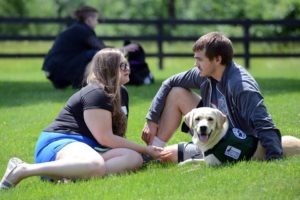Assistance Dogs Change Lives: Listen on The Spark

Listen to Susquehanna Service Dogs on The Spark with WITF
“Having my [assistance] dog with me made such a difference in the stress levels at work that I got healthier,” said Ramon Selove during an interview on The Spark with WITF. “I ended up being able to complete my whole thirty years with a normal retirement. It was ten years of work history that nobody thought I would have. In fact, my physician told my wife that I wasn’t going to be alive. But [having my assistance dog] just made all the difference in the world for me.”
Ramon is a retired professor of anatomy and physiology, and he’s currently partnered with his second assistance dog from Susquehanna Service Dogs. He, along with his son Nathan Selove, who is also a professor and partnered with an assistance dog, and Kelsey Parsons, Susquehanna Service Dogs’ Director of Assistance Dog Training, spoke with Aniya Faulcon on The Spark with WITF on February 7, 2023. His partnership with his first dog, SSD Coriander, is an example of how individualized SSD’s matching process is. Coriander liked to put people’s hands in her mouth and she was at Meet the Dogs, the process where people meet several potential assistance dogs, for training purposes rather than to be matched.
“She went for my hand and she gave me this very soft pressure on my hand,” said Ramon. “That pressure immediately caused me to calm down. This wouldn’t necessarily work for everybody, but for me, hand pressure like that made almost a miraculous difference.”
He has since trained his successor dog to perform similar hand pressure.
Meet the Dogs, where Ramon and Nathan met their assistance dogs for the first time, is the matching process that leads to the individualized training that each dog receives for their partner. People spend 10-15 minutes with each dog, first just hanging out with them to get to know them but then also practicing some basic training exercises.
“The person gives us their feedback about what they liked or disliked, or what would take some getting used to [about each dog],” said Kelsey. “We look at the body language of each dog and work to match the various personalities between the person and dog, as well as the home and work environments and the types of tasks that person will need.”
Each matched dog is then trained specifically to meet their partner’s needs. Prior to that specialized training, however, each dog spends about a year and half with volunteer puppy raiser families, learning basic cues, good house manners, and how to navigate public spaces.
“We can’t possibly train or prepare the dogs for every single situation, so our goal is to prepare them for novelty and new things,” said Kelsey. “We’re looking for dogs that can handle that without experiencing stress, without it impacting their ability to work or their ability to be happy in that environment.”
Those new environments may include school and work. Nathan’s assistance dog, SSD Blake, accompanies him to work. She’s his second assistance dog.
“[Service dogs] made it so I could go to college, so I could go to graduate school,” said Nathan. “It lets me get through my day in ways I was never able to before I had a service dog. It’s hard for me to think about how things were before service dogs were a part of my life. I can’t imagine life without service dogs now.”
In order to facilitate these life-changing partnerships, SSD depends on volunteer puppy raisers for the first eighteen months of the dogs’ lives. To learn more about becoming a puppy raiser, visit Susquehanna Service Dogs on our website.


